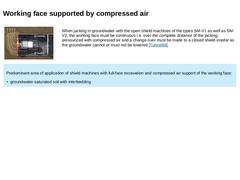
|
|
(Image: Shield machine with full-face excavation - working face with compressed air support (SM-V3)) |
When jacking in groundwater with the open shield machines of the types SM-V1 as well as SM-V2, the working face must be continuous i.e. over the complete distance of the jacking, pressurized with compressed air and a change over must be made to a closed shield insofar as the groundwater cannot or must not be lowered [Tunnel98]. |
|
Predominant area … |
|
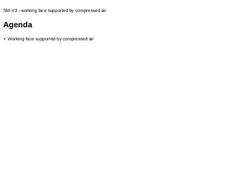
|

|
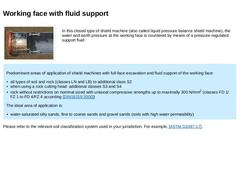
|
|
(Image: Shield machine with full-face excavation - working face with fluid support (SM-V4)) |
In this closed type of shield machine (also called liquid pressure balance shield machine), the water and earth pressure at the working face is countered by means of a pressure-regulated support fluid. |
|
Predominant areas of application of shield machines with full-face excavation and fluid support of the working face: -
all types of soil and rock (classes …
|
|
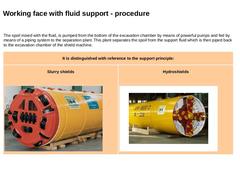
|
The spoil mixed with the fluid, is pumped from the bottom of the excavation chamber by means of powerful pumps and fed by means of a piping system to the separation plant. This plant separates the spoil from the support fluid which is then piped back to the excavation chamber of the shield machine. |
|
It is distinguished with reference to the support principle: |
|
Slurry shields (Image: Slurry shield with rock cutting head of type AVN 1500 T (external … |
|
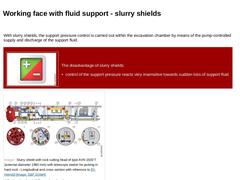
|
With slurry shields, the support pressure control is carried out within the excavation chamber by means of the pump-controlled supply and discharge of the support fluid. |
|
(Image: Pros and cons) |
The disadvantage of slurry shields: -
control of the support pressure reacts very insensitive towards sudden loss of support fluid
|
|
|
(Image: Slurry shield with rock cutting head of type AVN 1500 T (external diameter 1980 mm) with telescope station for … |
|
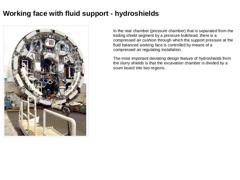
|

|
(Image: Hydroshield without boring head) |
In the rear chamber (pressure chamber) that is separated from the trailing shield segment by a pressure bulkhead, there is a compressed air cushion through which the support pressure at the fluid balanced working face is controlled by means of a compressed air regulating installation.
The most important deviating design feature of hydroshields from the slurry shields is that the excavation chamber is divided … |
|
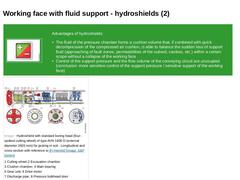
|
|
(Image: Pros and cons) |
Advantages of hydroshields: -
The fluid of the pressure chamber forms a cushion volume that, if combined with quick decompression of the compressed air cushion, is able to balance the sudden loss of support fluid (approaching of fault zones, permeabilities of the subsoil, cavities, etc.) within a certain scope without a collapse of the working face
-
Control of the support pressure and the flow volume of the conveying circuit …
|
|
|
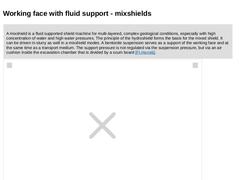
|
|
A mixshield is a fluid supported shield machine for multi-layered, complex geological conditions, especially with high concentration of water and high water pressures. The principle of the hydroshield forms the basis for the mixed shield. It can be driven in slurry as well in a mixshield modes. A bentonite suspension serves as a support of the working face and at the same time as a transport medium. The support pressure is not regulated via the … |
|
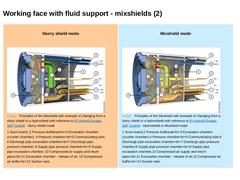
|
|
Slurry shield mode (Image: Principles of the Mixshield with example of changing from a slurry shield to a hydroshield with reference to [FI-Herreb] [Image: S&P GmbH] - Slurry shield mode) |
Mixshield mode (Image: Principles of the Mixshield with example of changing from a slurry shield to a hydroshield with reference to [FI-Herreb] [Image: S&P GmbH] - Hydroshield or Mixshield mode) |
|
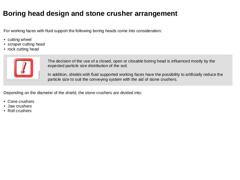
|

|
For working faces with fluid support the following boring heads come into consideration: -
cutting wheel
-
scraper cutting head
-
rock cutting head
|
|
(Image: Attention!)
The decision of the use of a closed, open or closable boring head is influenced mostly by the expected particle size distribution of the soil.
In addition, shields with fluid supported working faces have the possibility to artificially reduce the particle size to suit the conveying … |
|
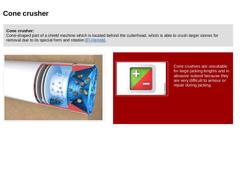
|

| Cone crusher:
Cone-shaped part of a shield machine which is located behind the cutterhead, which is able to crush larger stones for removal due to its special form and rotation [FI-Herreb]. | | | | (Image: Converting versions of the EPB UNCLEMOLE - Sketch of the principle of the slurry shield mode with reference to [FI-Isekib] [Image: S&P GmbH]) | (Image: Pros and cons) Cone crushers are unsuitable for large jacking lengths and in abrasive subsoil because … |
|
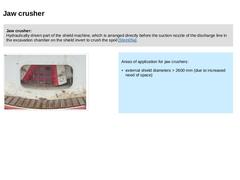
|
|
Jaw crusher:
Hydraulically driven part of the shield machine, which is arranged directly before the suction nozzle of the discharge line in the excavation chamber on the shield invert to crush the spoil [Stein05a]. |
|
|
|
(Image: Jaw crusher with rake arranged on the shield invert) |
Areas of application for jaw crushers: -
external shield diameters > 2600 mm (due to increased need of space)
|
|
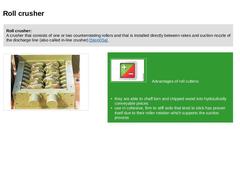
|
|
Roll crusher:
A crusher that consists of one or two counterrotating rollers and that is installed directly between rakes and suction nozzle of the discharge line (also called in-line crusher) [Stein05a]. |
|
|
|
(Image: Dismantled roll crusher (MOCO system [FI-Moco]) of a hydroshield with a shield diameter of 1966 mm [FI-Dywida]) |
(Image: Pros and cons)
Advantages of roll cutters: -
they are able to chaff torn and chipped wood into hydraulically conveyable …
|
|
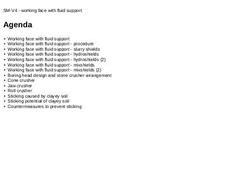
|

|
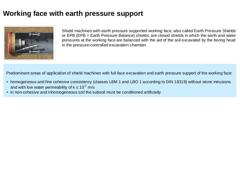
|

| (Image: Shield machine with full-face excavation - working face with earth pressure support (SM-V5))
|
Shield machines with earth pressure supported working face, also called Earth Pressure Shields or EPB (EPB = Earth Pressure Balance) shields, are closed shields in which the earth and water pressures at the working face are balanced with the aid of the soil excavated by the boring head in the pressure-controlled excavation chamber. | |
Predominant … |
|
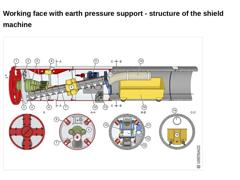
|

| (Image: Earth pressure balance shield of type EPB 1500 (external diameter 1830 mm) with transport cart with reference to [FI-Herreb] [Image: S&P GmbH] - Longitudinal and cross sections)
|
|
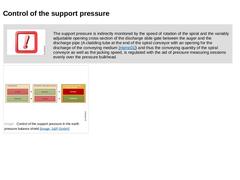
|
|
(Image: Attention!)
The support pressure is indirectly monitored by the speed of rotation of the spiral and the variably adjustable opening cross-section of the discharge slide gate between the auger and the discharge pipe (A cladding tube at the end of the spiral conveyor with an opening for the discharge of the conveying medium [Herre01]) and thus the conveying quantity of the spiral conveyor as well as the jacking speed, is regulated with the … |
|
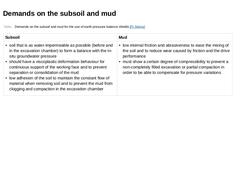
|
|
(Table: Demands on the subsoil and mud for the use of earth pressure balance shields) |
|
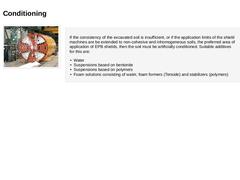
|
(Image: Possibilities of foam conditioning - Sketch of principle - Test run of a shield machine DN/ID 1500 in the works [FI-Herreb]) If the consistency of the excavated soil is insufficient, or if the application limits of the shield machines are be extended to non-cohesive and inhomogeneous soils, the preferred area of application of EPB shields, then the soil must be artificially conditioned. Suitable additives for this are: -
Water
-
Suspensions based …
|
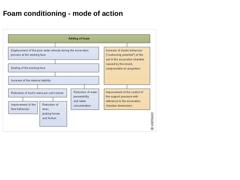
|

(Image: Mode of action of foam conditioning) |
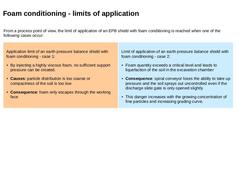
|
|
From a process point of view, the limit of application of an EPB shield with foam conditioning is reached when one of the following cases occur: |
|
Application limit of an earth pressure balance shield with foam conditioning - case 1: -
By injecting a highly viscous foam, no sufficient support pressure can be created.
-
Causes: particle distribution is too coarse or compactness of the soil is too low
-
Consequence: foam only escapes through the working …
|
|
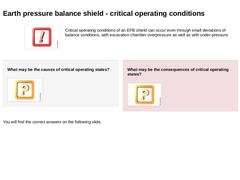
|
Critical operating conditions of an EPB shield can occur even through small deviations of balance conditions, with excavation chamber overpressure as well as with under-pressure. What may be the causes of critical operating states? (Image: Question) What may be the consequences of critical operating states? (Image: Question) You will find the correct answers on the following slide. |
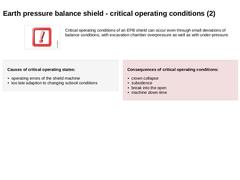
|
Critical operating conditions of an EPB shield can occur even through small deviations of balance conditions, with excavation chamber overpressure as well as with under-pressure. Causes of critical operating states: -
operating errors of the shield machine
-
too late adaption to changing subsoil conditions
Consequences of critical operating conditions: -
crown collapse
-
subsidence
-
break into the open
-
machine down-time
|
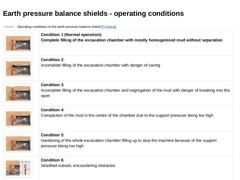
|

(Table: Operating conditions of the earth pressure balance shield [FI-Steina]) |
|
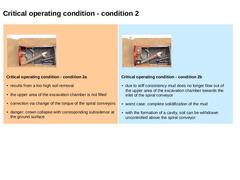
|
|
(Image: EPB shield with incomplete filling of the working chamber with danger of caving (Condition 2a) with reference to [Wilms95] [Image: S&P GmbH])
Critical operating condition - condition 2a -
results from a too high soil removal
-
the upper area of the excavation chamber is not filled
-
correction via change of the torque of the spiral conveyors
-
danger: crown collapse with corresponding subsidence at the ground surface
|
(Image: EPB shield with … |
|